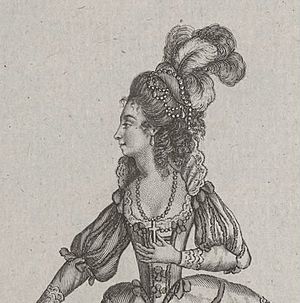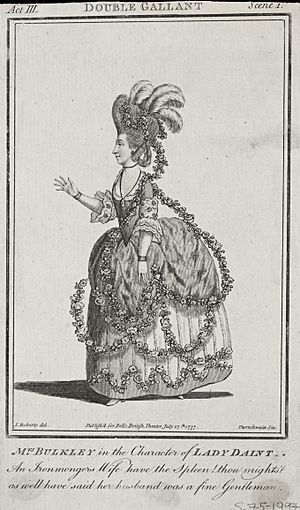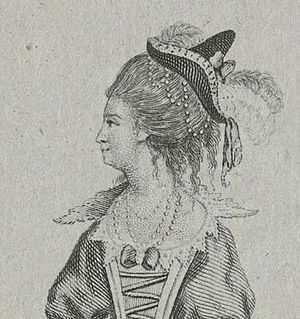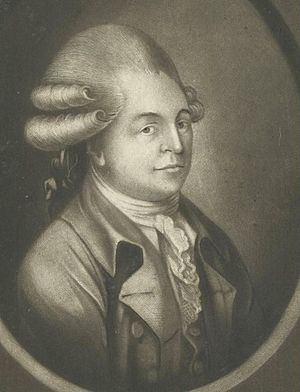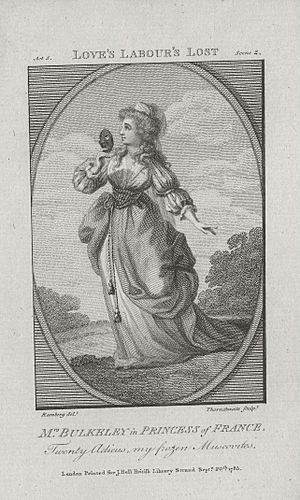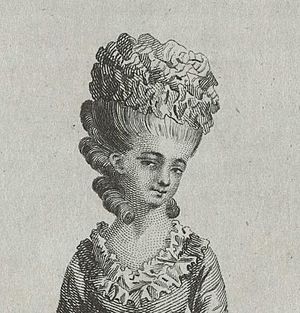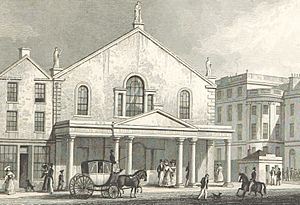Mary Bulkley facts for kids
Quick facts for kids
Mary Bulkley
|
|
|---|---|

Mrs Bulkley as Mrs Wilding in Gamesters (1778)
|
|
| Born | 1747 or 1748 Possibly London, England
|
| Died | 19 December 1792 (aged 44 or 45) Dumfries, Scotland
|
| Nationality | British |
| Other names | Stage names: Mrs Bulkley; Miss Bulkley. Maiden name: Mary Wilford 2nd married name: Barresford |
| Occupation | Dancer, comedian, actor |
| Years active | 1758–1791 |
| Known for | Dancing, acting in Shakespearean and contemporary comedies |
| Spouse(s) | George Bulkley (d. 1784); Captain Ebenezer Barresford |
| Children | 3 |
Mary Bulkley, born Mary Wilford (1747/8 – 1792), was a famous English dancer and comedy actress in the 1700s. She was known by her stage names, including Mrs Bulkley and Miss Bulkley. Later, she was also known as Mrs Barresford.
Mary performed in many theatres, like the Covent Garden Theatre in London, the Theatre Royal, Dublin in Ireland, and the Theatre Royal, Edinburgh in Scotland. She acted in most of William Shakespeare's comedies and several tragedies. She also appeared in many popular plays of her time. Mary even played the role of Hamlet at least twice, which was unusual for a woman then! When she was young, people thought she was very beautiful and praised her acting talent.
Contents
Early Life and Family
Mary Bulkley was born Mary Wilford. Her father, Edward Wilford, worked as an official and treasurer at the Covent Garden Theatre. Mary grew up in a theatrical world because her uncle, John Rich, owned the theatre. This meant she was comfortable and familiar with the stage from a young age.
When she was about 19 or 20, Mary was considered very beautiful. A writer named Hugh Kelly described her as having a "person wholly without fault." She was known for her graceful movements on stage.
Marriages and Children
Mary Wilford married George Jackson Bulkley in August 1767. He was a violin player in the Covent Garden orchestra. Mary had three children: Mary Elizabeth Bulkley (born 1768), George Wilford Bulkley (born 1769), and William Fisher Bulkley (born 1771).
Later in her life, Mary faced some challenges. She struggled financially and her health declined. She passed away in Dumfries, Scotland, in December 1792, at the age of 44 or 45. She was buried in St Michael's churchyard there.
Acting Career
Mary Bulkley started her career as a dancer at the Covent Garden Theatre when she was only ten years old in 1758. She continued dancing there until 1765. Around the age of 18, she began performing as a comedy actress. In 1769, she even took part in a special show where she helped a performer who drank a glass of wine while standing on two horses at full speed!
Mary performed in many plays throughout her career. Her first role as a comedian at Covent Garden was Miranda in The Busie Body. She also appeared in the first performances of several plays that are still famous today. These include The Good-Natur'd Man (where she played Miss Richland in 1768), She Stoops to Conquer (as Constantia Hardcastle in 1773), and The Rivals (as Julia Melville in 1775).
Even though Shakespeare's plays were often changed for performances back then, Mary performed in all of his comedies. She also played serious roles like Cordelia in King Lear and Portia in The Merchant of Venice.
At Covent Garden Theatre
In 1773, the play She Stoops to Conquer by Oliver Goldsmith first opened at Covent Garden. It was a big success! Mary Bulkley played Miss Hardcastle and delivered the final speech, called the epilogue. However, she couldn't sing, so a song in her character's part was left out. Famous people like Oliver Goldsmith, Samuel Johnson, and Joshua Reynolds were at the rehearsals for this play.
There was a small disagreement between Mary Bulkley and another actress, Ann Catley, about who should perform the epilogue. The theatre owner, George Colman, decided that Mary should perform it.
Performing in Dublin and Shrewsbury
In May 1774, Mary Bulkley arrived in Dublin, Ireland. Her first role there was Beatrice in Much Ado About Nothing at the Theatre Royal, Dublin. This play was advertised as a "revival" in the local newspaper. Sometimes, her performances were followed by a shorter, funny play called a farce. She appeared in a farce called Miss in her Teens. A few days later, she was in The Clandestine Marriage and another farce called The Citizen.
In 1775 and 1776, Mary performed in several plays at Shrewsbury Theatre. These included Jane Shore, The English Tars in India, The Country Girl, and The Life and Death of Julius Caesar. A newspaper review in 1775 praised her and another actor, saying they "displayed... the most pleasing and excellent abilities as comedians." In 1776, they performed in Richard III and a farce called Bonton.
Return to Covent Garden
Between 1776 and 1778, pictures of Mary Bulkley in her acting roles started appearing in a famous theatre publication called Bell's British Theatre. However, during the 1779–1780 season, some audience members showed their disapproval during one of her performances. This was because of details about her private life that had become public.
During a performance of The Merchant Of Venice, where she played Portia, Mary stopped the play to speak to the audience. She told them that as an actress, she always tried her best for the public. She asked them to respect her private life. After this, her career at Covent Garden began to slow down, and she appeared there less often.
In the 1783–1784 season, she again faced disapproval from the audience due to her personal life. Despite these moments, for most of her career, her beauty and talent were highly praised.
Performing in Edinburgh
Mary Bulkley arrived in Edinburgh, Scotland, around 1781. In January 1782, she had a disagreement with the manager of the Theatre Royal, Edinburgh about which roles she should play. This led to letters being published in the local newspaper, the Caledonian Mercury. The manager replied, saying he would not pay attention to her letters.
However, Mary did perform at the Theatre Royal, Edinburgh, in 1782. She appeared in the comedy Wonder, a Woman Keeps a Secret and the farce Three Weeks After Marriage. She also played in The Constant Couple, The Rivals, The Maid of the Oaks, and An Englishman in Paris. In some of these plays, she performed a special dance called a minuet.
On March 23, 1784, Mary Bulkley successfully played the part of Hamlet at the Theatre Royal, Edinburgh. By April 1785, she was still performing in Edinburgh in plays like The Clandestine Marriage, The Jealous Wife, A Trip to Scarborough, and The Critic. She also recited a final speech called Belles Have At Ye All. In May of the same year, she performed in Rule a Wife and Have a Wife, Deuce Is In Him, Wonder; A Woman Keeps a Secret, and The Sultan. She played Hamlet again that month and appeared in School for Scandal.
By 1788, Mary was still performing in Edinburgh in plays such as Much Ado About Nothing, The Sultan, The Provok'd Husband, Tender Husband, The Wonder; A Woman Keeps a Secret, The Maid of the Oaks, The School for Wives, and Young Quaker. She also performed a dance called Jamie's Return and her special minuet.
Later Career as Mrs Barresford
Mary Bulkley performed as Mrs Barresford in Edinburgh between 1789 and 1791. Even though she was getting older and might have been ill, she worked regularly. The theatre manager, Jackson, continued to praise her performances.
In 1789, Mrs Barresford appeared in The Clandestine Marriage, The Citizen, The English Merchant, The Pannel, and The Heiress. She also performed in All in the Wrong, The Beaux' Stratagem, and The Critic. In 1790, she played Hippolyta in The Tempest, Fatima in Cymon, and Lady Gayville in The Heiress. She was also in The Maid of the Oaks, which included her famous minuet, and The Brothers. She spoke the epilogue for Vimonda.
In 1791, she played Lady Macbeth for the first time and danced a minuet at the end of the play. On the same night, she was in the farce Lethe. She also appeared in I'll Tell You What and The Miser. She played the Queen in Hamlet and was in Three Weeks After Marriage again. Her last known performances were in The Fashionable Lover and Tit For Tat. She was scheduled to perform in 1792, but it is not known if she did.
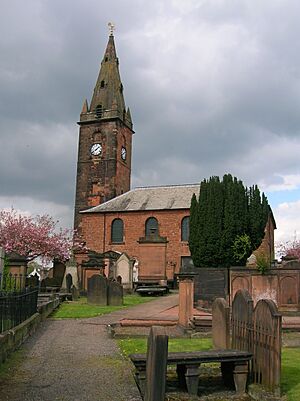
Career Decline
During her years in Edinburgh, Mary Bulkley also worked during the summer at the Haymarket Theatre in London. She briefly worked at Drury Lane in 1782 and for the 1783–1784 season. She also made one appearance at Covent Garden as Mrs Barresford in 1789–1790. Work was harder to find during the winter months. In 1784, she performed with traveling actors in Shrewsbury. She stayed with the Theatre Royal Edinburgh company until 1791.
See also


